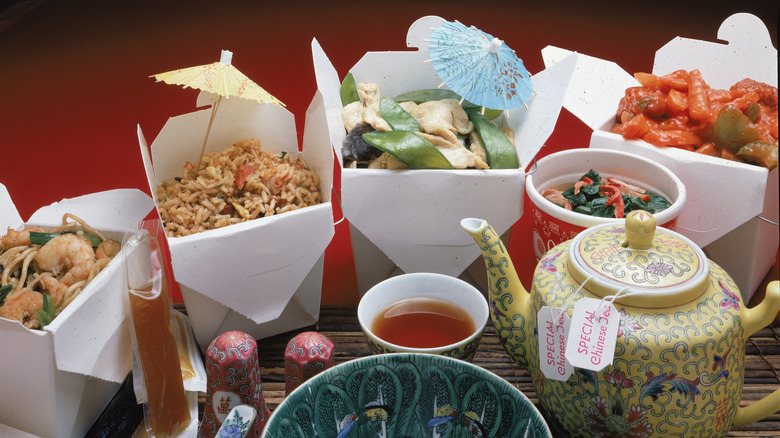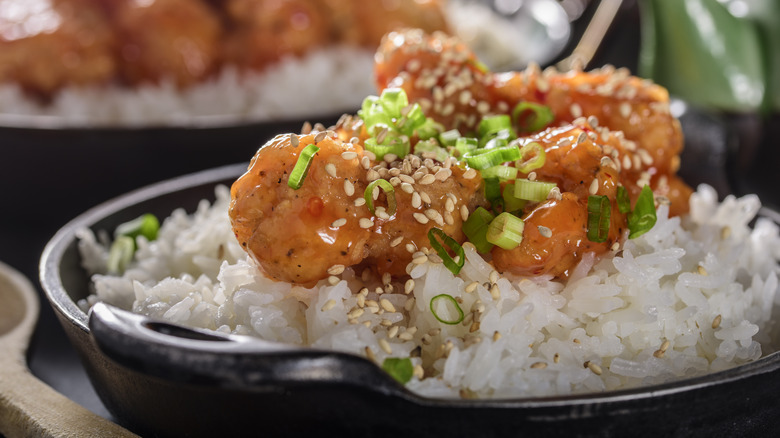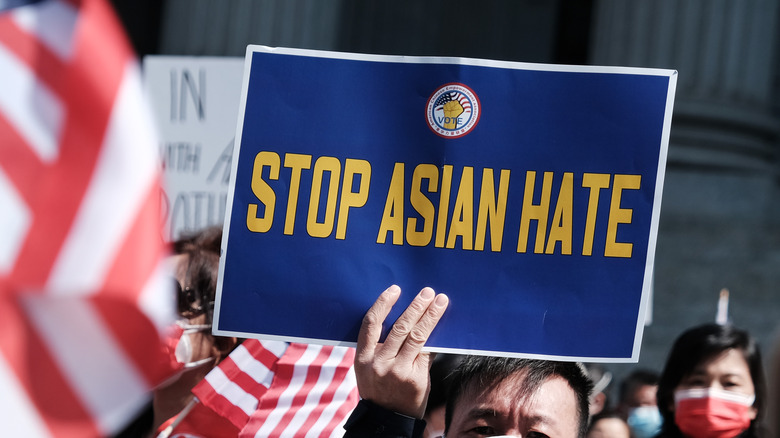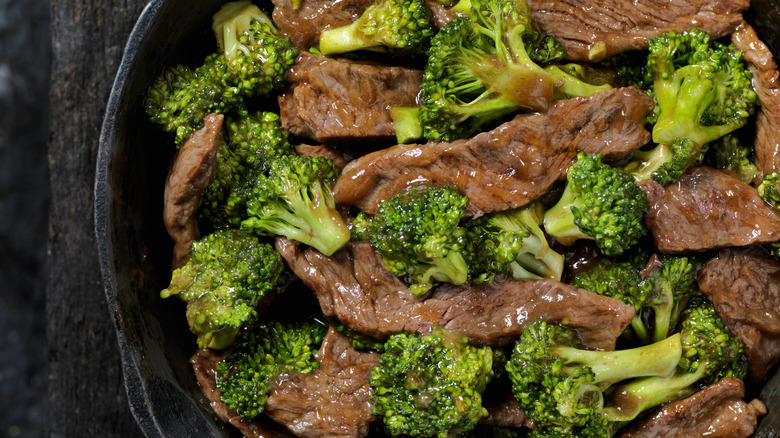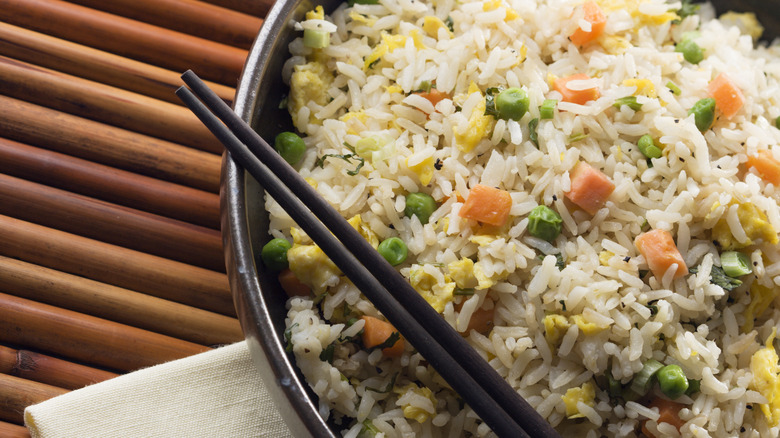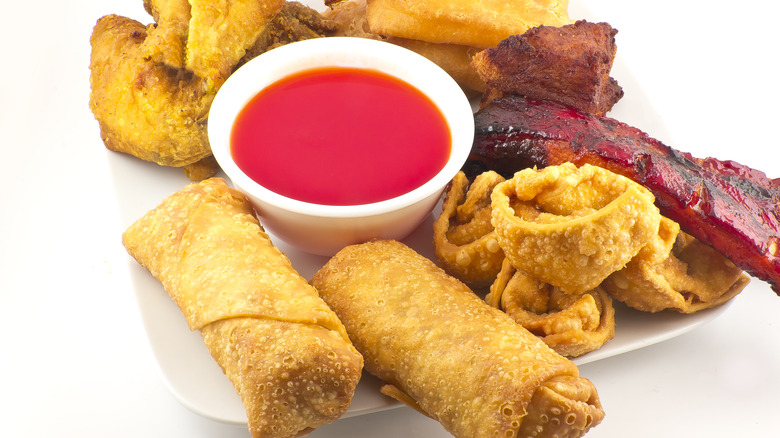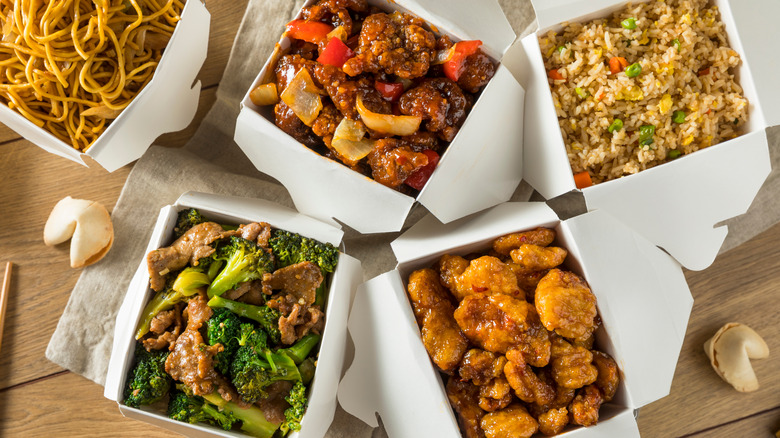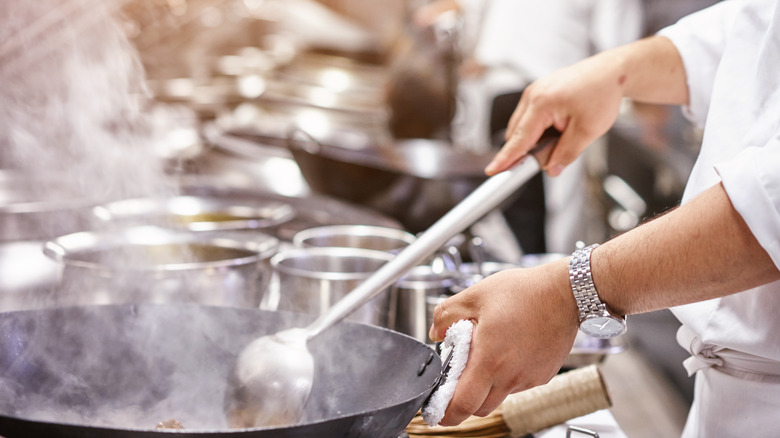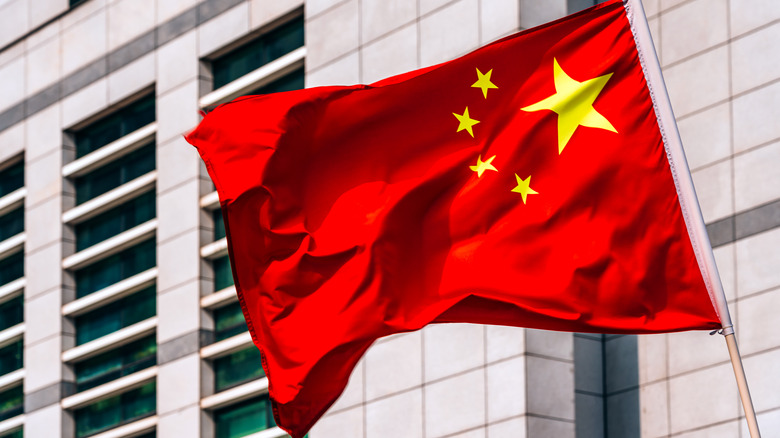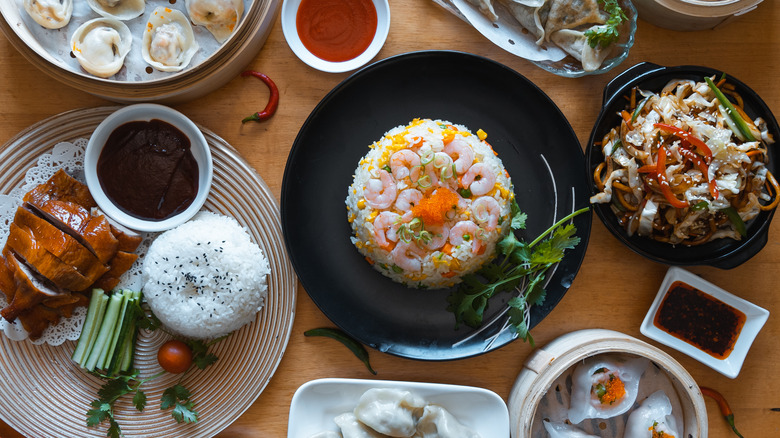We Finally Know Why Chinese Food Is So Cheap
We just love a bargain. And while cost isn't our only (or even the first) consideration when it comes to ordering food from a restaurant, we do appreciate those low-priced dishes that double as a delectable type of cuisine — hence our unabashed love for Chinese food.
Now, given the current economic climate in the U.S. and around the world in 2023 (and the concurrent inflation of a variety of food prices), it's not entirely accurate to declare any food as economical, so to speak. Still, the historical trend of Chinese food (and we're talking American-style Chinese food) as a cost-effective option — one on par with fast food, in many ways — is impossible to deny.
Of course, the simple fact that Chinese food has been a consistently inexpensive cuisine in the U.S. doesn't really illuminate why it's so cheap in the first place. In fact, the story of how this reliably delicious style of food became a low-cost staple may surprise you — in ways both good and bad. Since we finally know why Chinese food is so cheap, we decided to share that insight with the world. Here's the lowdown (or the whole egg roll) on why Chinese food is such a low-cost cuisine in the U.S.
American Chinese food isn't authentic Chinese cuisine
Is there anyone out there who believes the Chinese food found at the average U.S. takeout spot (like sweet and sour pork or beef with broccoli) is genuine to what's served in China? Perhaps. But we'd be willing to bet far more readers are familiar with the notion that American Chinese food is precisely that: an Americanized variation of Chinese-style dishes. Either way, this leads us to an essential reason for Chinese food's low prices in the U.S. — the cuisine generally consists of recipes amended to incorporate what's popular (and readily available) in the U.S.
If you're unsure how the lack of authenticity found in most U.S.-based Chinese restaurants translates to cheaper costs for consumers, it's much simpler than you're imagining. After all, the use of locally found ingredients (rather than potentially difficult-to-find foods that may need to be imported into the country) drastically lowers the overall costs for Chinese food business owners.
Now, you might believe American Chinese food was created with the intent of appealing to the American palate. But it actually sprung from Chinese-American chefs adapting to their new circumstances to create dishes that would please their fellow Chinese immigrants. Of course, this meant American Chinese food was apt to attract U.S.-born diners as well — and the rest, as they say, is history.
Many U.S. consumers expect cheap prices due to lingering stereotypes about Chinese immigrants
When a person views something as low quality, it's likely that they aren't willing to pay more than the bare minimum for that product. Some Americans (often named Karen) may even be prone to fits of fury if an item costs more than the expected price — like a standard Chinese food order. Unfortunately, one of the main reasons why Chinese food became pigeonholed as cheap cuisine has nothing to do with the cuisine itself — and everything to do with many Americans' historically negative views of China and Chinese-American immigrants.
We certainly wish the abhorrent, bigoted (and long-running) treatment of immigrants from China played no part in Chinese cuisine's overall affordability. But the reality is that Chinese food largely came to be categorized as a cheap, low-rent food option because Chinese-American immigrants were viewed in that manner by many native-born Americans — a discriminatory pattern that began during the 19th century Gold Rush in California.
As Beth Lew-Williams, an assistant professor of Asian-American history at Princeton University, told HuffPost in 2017, the prevailing belief was immigrants from China "could not become Americanized," as they "were simultaneously racially inferior, backwards, (and) savage." Consequently, many U.S. residents concluded anything associated with Chinese-American immigrants was inferior and unworthy of fair value, including the food — an attitude that's reverberated into the 21st century.
Popular dishes like beef and broccoli utilize low-cost ingredients
It's no secret that many popular American Chinese food dishes aren't entirely authentic to the counterparts served in China. Of course, the modifications made by Chinese-American chefs to traditional recipes wasn't by chance, but usually meant to replace impossible-to-find ingredients with those that were locally available in the U.S. And since most modern Chinese food restaurants continue to utilize many of those same inexpensive, easily accessible ingredients, it helps keep the overall cost down — for both restaurants and customers.
Consider the immensely popular dish known as beef and broccoli. Even if this meat-and-vegetable combo had originally been developed in mainland China — rather than by Chinese-American immigrants during the early-to-mid 20th century — the dish's ubiquitously available, consistently affordable main ingredients (broccoli and flank steak) mean it was destined to remain cheap in the U.S.
Another example would be General Tso's chicken, the deep-fried, sweet-and-spicy dish adapted for the U.S. palate. Composed of poultry, a simple batter, and sugar-heavy sauce, the dish has a relatively simple makeup that helps keep the price low — as does the makeup of beef and broccoli and countless other Chinese food dishes in U.S.-based restaurants.
The flexible nature of fried rice dishes allows for a simple (and cheap) preparation
One glance at a Chinese food menu reveals a bevy of different fried rice styles, with any number of added meats or vegetables available to customers. But rather than making new, individualized batches of rice for each new fried rice order, most Chinese food restaurants are apt to use a large batch of premade rice as a base (adding additional ingredients only as needed). This shortens the time it takes to serve a completed dish while potentially reducing the overall labor costs (along with the menu price) for fried rice in the process.
Now, the fact that fried rice doesn't appear to be a staple of haute cuisine in China undoubtedly plays a part in its cheap existence among American Chinese food. The dish appears to have roots as a single-pan-type dish favored by the lower classes and prepared to simplify the cooking process while consolidating whatever available food was on hand. In other words, if fried rice wasn't looked upon as a highfalutin (or high-cost) menu item by Chinese-American immigrants, why would they have expected U.S. consumers to pay a premium price?
Additionally, takeout fried rice is usually made with affordable white rice varieties in the U.S., which plays a hand in the item's general cost-effectiveness among American Chinese food items as well.
Some restaurants eschew customer service to keep prices low
If an establishment realizes it has a less-than-stellar reputation when it comes to service, will it bother to fix it — or choose to lean into the public's perception? We can't say (we're not mind readers). But seeing how an alleged dearth of customer service at Chinese food restaurants appears to be a fairly common belief, some business owners may have chosen to fulfill that expectation by skimping on the total number of employees (thus ensuring prices remain concurrently low).
Actually, if there's a genuine perception of Chinese food restaurants offering subpar customer service, it may have more to do with cultural differences than anything else. After all, as one Chinese national wrote on Quora in 2014, many Chinese restaurant owners likely believe customers "come to restaurants to eat good food, not to be forcefully treated like a king and pay extra for it."
Now, we're not trying to accuse every single Chinese food establishment of dropping the ball when it comes to customer service. But if you're wondering why the person sounds so curt on the phone the next time you order Chinese food, ask yourself: Do you prefer a friendly and jovial demeaner — or an excessively low-priced lunch special?
Many items are deep-fried, which allows for faster, high-volume cooking times
Here in the U.S., we have a tendency to deep fry everything (hence the obesity epidemic that the nation's been struggling to overcome for decades). Of course, the fact this cooking style is beloved explains (in part) why so many American Chinese food products are prepared through this method. But it also illustrates a prominent reason for the cuisine's many low-priced options. After all, deep frying quickly cooks food in large, uniformly prepared batches, thus lowering the cost (and time spent) preparing those items — and keeping them cheap for consumers as well.
Now, the simple fact that so many types of American Chinese food dishes are prepared in deep-fried cooking oil isn't the sole reason for their general cheapness. But it certainly advances the narrative that authentic Chinese food is going to cost a substantial amount more than the Americanized variations; after all, virtually no traditional Chinese food is prepared via the deep fryer.
For anyone wondering how frying foods reduces expenses (because oil has to be expensive, too, right?), most cooking oils are actually quite affordable. And while restaurants aren't required (or even encouraged) to pass on these savings to the customer, it seems many Chinese food restaurants have chosen to do so.
It's often viewed by U.S. diners as a takeout or delivery-exclusive food option
Very few people are enthralled with the notion of paying a hefty sum for a standard takeout or delivery food order. In that sense, when you consider Chinese food is often categorized among takeout and delivery establishments, there is a cap on how much consumers are willing to pay. Not only that, but the idea places a limit on how much Chinese food restaurants can charge without losing business.
Would you be willing to pay the same price for a Whopper as you'd pay for a cheeseburger made at a local pub that features locally sourced ingredients of the highest quality? Would anyone? Of course, we don't mean to imply the majority of Chinese food restaurants don't use the highest-quality ingredients. But the fact is the unfair perception of Chinese cuisine as being cheaply prepared appears to be deeply ingrained with many Americans.
Now, if the impression of Chinese food can evolve beyond the category of an exclusively takeout or delivery option, perhaps its prices can rise alongside public opinion. Then again, since Chinese food helped popularize modern-day delivery, it's tough to believe it'll shed the label of cheap cuisine anytime soon.
Restaurants may not pay employees a fair (or legal) wage
The entire basis of capitalism tends to revolve around a business making as much money as possible (often with little to no regard for the financial well-being of the world around it). Unfortunately, some Chinese food restaurant owners in the U.S. (and, evidently, in Canada) are so blinded by the almighty dollar that they're willing to cut corners in every scenario — including their employees' wages. In that sense, one of the less savory explanations for how (some) Chinese food restaurants keep menu prices low is by underpaying employees (often egregiously).
Now, we may not like to think about the stunningly low (and exorbitantly unfair) rate of pay for labor in some professional sectors. But the reality is this sort of tradeoff with Chinese food establishments — where many employees' required workloads far exceed their pay so customers can reap the benefit of low prices — has become part of modern U.S. culture.
Were we disheartened to discover the often-terrible wages made by Chinese food restaurant workers may be responsible for our $5 egg roll and fried rice combo plate? Absolutely. But we're required to report truth as we uncover it (whether or not it offends our delicate sensibilities).
Employees are often overworked and underpaid -- but so desperate they continue working
The mind-boggling work ethic displayed by many immigrants in the U.S. is impressive. Whether those folks are driven by a need to prove their worth to their new countrymen (and women) or something else entirely, many non-native U.S. residents are undeniably willing to work themselves to the bone. Of course, the unfortunate reality is some immigrants find themselves unable to obtain anything substantial beyond a grueling, backbreaking (and low-paying) job — including many of the Chinese food restaurant employees.
Now, restaurants have always operated under the notion that higher wages lead to higher prices for customers. Still, some restaurant owners (particularly those serving Chinese cuisine) appear all too quick to take advantage of immigrant employees desperate for work — creating a vicious cycle where low-paid, overworked employees have no other choice but to continue being professionally abused to survive.
Additionally, there's a marked difference between aiming to save a few bucks and the appallingly unethical (and, at times, illegal) practices employed by some Chinese food restaurants in the name of cheap labor (and cheap lo mein). But we suppose it's a bit like discovering how sausage is made — we'll still eat Chinese food, but we're a bit turned off after peeking behind the curtain.
Unfair perceptions of China means many U.S. individuals simply refuse to pay a premium
The relationship between the U.S. and China has been historically rocky — even before the fascinatingly bizarre balloon controversy in early 2023 (when a Chinese spy balloon vessel was seen, then shot down, over U.S. territory). In fact, a wide-ranging resentment toward all-things-China has handicapped U.S. diners' perspective of Chinese food over time, keeping the food inexpensive (as the prevailing wisdom states anything associated with China must be cheap).
Now, as we've noted several times, the seemingly arbitrary discrimination of Chinese-American immigrants (stretching back to the 19th century) has kept Chinese cuisine from rising in stature alongside other ethnic food categories. After all, as Krishnendu Ray, an associate professor of food studies at New York University, told The Atlantic in 2016, many modern Americans are "still filled with this funny disdain that (China) is about ... cheap and crappy food."
Can we envision many U.S. residents positively amending their opinion of China (and, consequently, Chinese-American immigrants) in the near future? Not really. So it appears we can expect American Chinese food to remain cheap (or, at least, on the lower end of the price spectrum) — though we're less thrilled by that prospect than we'd like to be.
Authentic Chinese cuisine is not, in fact, cheap -- nor should it be
Any American who's ever stepped outside their culinary comfort zone likely knows many ethnic restaurants come with a considerable price tag. Of course, whether it's a matter of prestige, or a willingness to pay a premium for imported (and custom) ingredients, we're never shocked when expected to pay an exorbitant sum for a meal at an Italian or Japanese establishment. In other words, if you'd like to experience the very best of authentic Chinese food, you'll likely have to venture past your neighborhood takeout spot — and prepare to spend a pretty penny in the process.
Now, if you didn't realize the label of "cheap" Chinese food applies only to the highly amended style found at your local Panda Express, well ... that's what we're here for. But there are actually countless highly skilled culinary artisans from China (or of Chinese descent) around the U.S. (and world) eagerly working to shift the cultural perception of Chinese food — thereby elevating the cuisine to its deserved pedestal.
Whether a majority of the U.S. population will ever become comfortable with the idea of paying a fair price for Chinese food is impossible to say. But if you're curious about the real deal Holyfield when it comes to, say, Hunan or Sichuan cuisine, accept the upcharge, and give authentic (not cheap) Chinese food a try.
